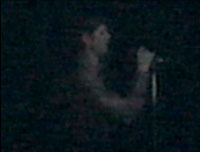|

Factory Archives (2001–02)

Phantom Release (2003)

Recorded Yesterday (2004)
|
|
Slater Bradley's Doppelganger Trilogy (2001–04) conjures up three pop icons from the collective unconscious of our mass-mediated culture. All fallen heroes—two by suicide and one by a protracted descent into disrepute—these figures are perceived through the distancing lens of desire and memory. Each of the three videos is fashioned as a recording of a faux concert performance, using a technique reminiscent of what would have been employed to capture the event when it purportedly took place.
Factory Archives imagines Ian Curtis, lead singer of the short-lived punk band Joy Division, through the grainy haze of aging video stock. As if retrieved from the vaults of Factory Records, this fragment depicts an elusive performer just before the dawn of MTV, when the choreographed music video would forever change how culture consumes its rock 'n' roll. Phantom Release rehearses this cultural phenomenon as well as the ubiquitousness of the personal camcorder, offering an ersatz, "amateur" recording of Kurt Cobain playing the guitar. Its studied casualness and raw ambience evoke the countless bootleg videos that can be downloaded from any number of Web sites devoted to all things Nirvana. In Recorded Yesterday Michael Jackson is seen performing his signature dance moves on an otherwise empty stage. The black-and-white, Super-8 film footage of this lone figure appears to be disintegrating as it plays, creating a ghostly, retro atmosphere that reflects the melancholic reality of a once brilliant career spiraling out of control. Each chapter of the trilogy appears worn and overexposed, as if distorted by age. The effect is one of a vaguely remembered image, a dream dimly recalled at the break of day.
Bradley's "restagings" of these imagined performances reference specific moments in his own life when he first encountered the work of Joy Division, Nirvana, and Michael Jackson, and through them, the seduction of abandonment, the lure of celebrity, and the erotics of fan worship. His trilogy—and its related photographs and collages—compellingly complicates the autobiographical element by the involvement of the artist's "doppelganger." Since 1999 Bradley has been collaborating with Benjamin Brock, his veritable double, in a series of works that explore the psychologically charged space between one's self and mirror image. In myth and literature, the doppelganger is an apparition that portends one's own death, but its form has mutated over time to include the notion of double identity. In the trilogy Brock performs as Bradley playing the roles of Curtis, Cobain, and Jackson. Transformed by costume and posture, and further masked by the deteriorating stock on which he is seen, the doppelganger is at once everyone and no one. What emerges is a triangulation of reflections, an endless hall of mirrors that leads nowhere but to the recesses of the unconscious mind.
—Nancy Spector, Curator of Contemporary Art
Slater Bradley, The Doppelganger Trilogy, 2001–04. Projection from a digital source, Edition 1/3, Dimensions variable. Solomon R. Guggenheim Museum, New York. Purchased with funds contributed by the International Director's Council and Executive Committee Members: Ruth Baum, Edythe Broad, Elaine Terner Cooper, Dimitris Daskalopoulos, Harry David, Gail May Engelberg, Shirley Fiterman, Nicki Harris, Dakis Joannou, Rachel Lehmann, Linda Macklowe, Peter Norton, Tonino Perna, Elizabeth Richebourg Rea, Mortimer D.A. Sackler, Simonetta Seragnoli, David Teiger, Ginny Williams, and Elliot Wolk, 2004. 2004.73
|
|
